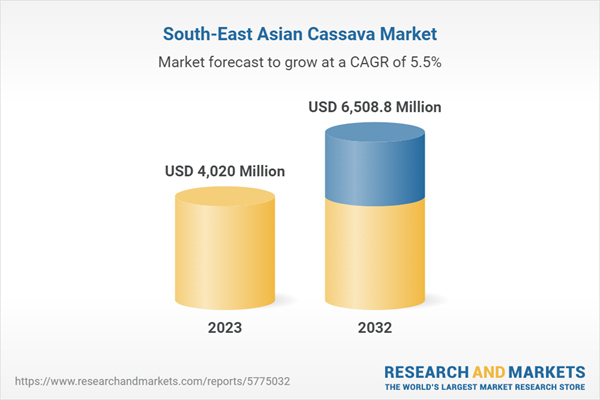Most Southeast Asian countries are traditional agricultural countries and are important producers and suppliers of crops globally. According to the publisher's analysis, with the economic growth in Southeast Asia and the development of downstream applications in the cassava industry, the market demand for cassava has gradually expanded and the production of cassava in Southeast Asia has increased. In addition to meeting domestic demand, Southeast Asia also exports a large amount of cassava to other overseas regions.
There are disparities in the degree of development of the cassava industry in Southeast Asia in different countries. According to the publisher's analysis, the cassava industry in Thailand, Cambodia, Laos and Vietnam is large in scale. For example, Thailand is the world's leading cassava producer and exporter, with a cassava plantation area of more than 8 million Thai acres and an annual output of more than 30 million tons, and the export volume of Thai cassava and its products reached 11.18 million tons in 2022. Cambodia is also one of the top ten cassava exporters in the world. After the rice industry, cassava industry has become the second pillar industry of Cambodian agriculture. Cambodia has also promulgated the National Cassava Policy 2020-2025, which plans to promote the transformation and upgrading of its cassava industry to produce more high value-added cassava products for a larger global cassava market share.
Southeast Asia in this report includes 10 countries: Singapore, Thailand, Philippines, Malaysia, Indonesia, Vietnam, Myanmar, Brunei, Laos and Cambodia. With a total population of nearly 700 million by the end of 2022, Southeast Asia has an overall economic growth rate higher than the global average and is one of the key drivers of future global economic growth.
According to the publisher's analysis, the economic levels of the 10 Southeast Asian countries vary greatly, with Singapore being the only developed country with a per capita GDP of about US$79,000 in 2022. While Myanmar and Cambodia will have a GDP per capita of less than US$2,000 in 2022. The population and minimum wage levels of each country also vary greatly. Brunei, which has the smallest population, will have a total population of less than 500,000 people in 2022, while Indonesia, which has the largest population, will have a population of about 280 million people in 2022.
The publisher expects the Southeast Asian cassava industry to continue to grow from 2023-2032.
Topics Covered
- Southeast Asia Cassava Industry Status and Major Sources in 2018-2022
- What is the Impact of COVID-19 on Southeast Asia Cassava Industry?
- Which Companies are the Major Players in Southeast Asia Cassava Industry Market and What are their Competitive Benchmarks?
- Key Drivers and Market Opportunities in Southeast Asia Cassava Industry
- What are the Key Drivers, Challenges, and Opportunities for Southeast Asia Cassava Industry during 2023-2032?
- What is the Expected Revenue of Southeast Asia Cassava Industry during 2023-2032?
- What are the Strategies Adopted by the Key Players in the Market to Increase Their Market Share in the Industry?
- What are the Competitive Advantages of the Major Players in Southeast Asia Cassava Industry Market?
- Which Segment of Southeast Asia Cassava Industry is Expected to Dominate the Market in 2032?
- What are the Major Adverse Factors Facing Southeast Asia Cassava Industry?
Table of Contents
1 Singapore Cassava Industry Analysis1.1 Singapore's Cassava Industry Development Environment
1.1.1 Geography
1.1.2 Population
1.1.3 Economy
1.1.4 Minimum Wage in Singapore
1.2 Singapore Cassava Industry Operation 2023-2032
1.2.1 Supply
1.2.2 Demand
1.2.3 Imports and Exports
1.3 Analysis of Major Cassava Producers and Traders in Singapore
2 Analysis of Thailand's Cassava Industry
2.1 Thailand Cassava Industry Development Environment
2.1.1 Geography
2.1.2 Population
2.1.3 Economy
2.1.4 Thailand Minimum Wage
2.2 Thailand Cassava Industry Operation 2023-2032
2.2.1 Supply
2.2.2 Demand
2.2.3 Import and Export
2.3 Analysis of Major Cassava Producers and Traders in Thailand
3 Analysis of Cassava Industry in the Philippines
3.1 Philippine Cassava Industry Development Environment
3.1.1 Geography
3.1.2 Population
3.1.3 Economy
3.1.4 Minimum Wage in the Philippines
3.2 Philippine Cassava Industry Operation 2023-2032
3.2.1 Supply
3.2.2 Demand
3.2.3 Imports and Exports
3.3 Analysis of Major Cassava Producers and Traders in the Philippines
4 Analysis of Malaysia's Cassava Industry
4.1 Malaysia's Cassava Industry Development Environment
4.1.1 Geography
4.1.2 Population
4.1.3 Economy
4.1.4 Minimum Wage in Malaysia
4.2 Malaysia Cassava Industry Operation 2023-2032
4.2.1 Supply
4.2.2 Demand
4.2.3 Import and Export
4.3 Analysis of Major Cassava Producers and Traders in Malaysia
5 Indonesia Cassava Industry Analysis
5.1 Indonesia Cassava Industry Development Environment
5.1.1 Geography
5.1.2 Population
5.1.3 Economy
5.1.4 Minimum Wage in Indonesia
5.2 Indonesia Cassava Industry Operation 2023-2032
5.2.1 Supply
5.2.2 Demand
5.2.3 Import and Export
5.3 Analysis of Major Cassava Producers and Traders in Indonesia
6 Analysis of Vietnam's Cassava Industry
6.1 Vietnam Cassava Industry Development Environment
6.1.1 Geography
6.1.2 Population
6.1.3 Economy
6.1.4 Minimum Wage in Vietnam
6.2 Vietnam Cassava Industry Operation 2023-2032
6.2.1 Supply
6.2.2 Demand
6.2.3 Import and Export
6.3 Analysis of Major Cassava Producers and Traders in Vietnam
7 Analysis of Myanmar's Cassava Industry
7.1 Myanmar Cassava Industry Development Environment
7.1.1 Geography
7.1.2 Population
7.1.3 Economy
7.1.4 Myanmar Minimum Wage
7.2 Myanmar Cassava Industry Operation 2023-2032
7.2.1 Supply
7.2.2 Demand
7.2.3 Import and Export
7.3 Analysis of Major Cassava Producers and Traders in Myanmar
8 Analysis of Brunei Cassava Industry
8.1 Brunei Cassava Industry Development Environment
8.1.1 Geography
8.1.2 Population
8.1.3 Economy
8.1.4 Brunei Minimum Wage
8.2 Brunei Cassava Industry Operation 2023-2032
8.2.1 Supply
8.2.2 Demand
8.2.3 Import and Export
8.3 Brunei Major Cassava Producers and Traders Analysis
9 Analysis of the Lao Cassava Industry
9.1 Lao Cassava Industry Development Environment
9.1.1 Geography
9.1.2 Population
9.1.3 Economy
9.1.4 Minimum Wage in Laos
9.2 Lao Cassava Industry Operation 2023-2032
9.2.1 Supply
9.2.2 Demand
9.2.3 Import and Export
9.3 Analysis of Major Cassava Producers and Traders in Laos
10 Analysis of Cambodia's Cassava Industry
10.1 Cambodia Cassava Industry Development Environment
10.1.1 Geography
10.1.2 Population
10.1.3 Economy
10.1.4 Minimum Wage in Cambodia
10.2 Cambodia Cassava Industry Operation in 2023-2032
10.2.1 Supply
10.2.2 Demand
10.2.3 Import and Export
10.3 Analysis of Major Cassava Producers and Traders in Cambodia
11 Southeast Asia Cassava Industry Outlook 2023-2032
11.1 Southeast Asia Cassava Industry Development Influencing Factors Analysis
11.1.1 Favorable Factors
11.1.2 Unfavorable Factors
11.2 Southeast Asia Cassava Industry Supply Analysis, 2023-2032
11.3 Southeast Asia Cassava Industry Demand Analysis 2023-2032
11.4 Impact of COVID -19 Epidemic on Cassava Industry
Methodology
Background research defines the range of products and industries, which proposes the key points of the research. Proper classification will help clients understand the industry and products in the report.
Secondhand material research is a necessary way to push the project into fast progress. The analyst always chooses the data source carefully. Most secondhand data they quote is sourced from an authority in a specific industry or public data source from governments, industrial associations, etc. For some new or niche fields, they also "double-check" data sources and logics before they show them to clients.
Primary research is the key to solve questions, which largely influence the research outputs. The analyst may use methods like mathematics, logical reasoning, scenario thinking, to confirm key data and make the data credible.
The data model is an important analysis method. Calculating through data models with different factors weights can guarantee the outputs objective.
The analyst optimizes the following methods and steps in executing research projects and also forms many special information gathering and processing methods.
1. Analyze the life cycle of the industry to understand the development phase and space.
2. Grasp the key indexes evaluating the market to position clients in the market and formulate development plans
3. Economic, political, social and cultural factors
4. Competitors like a mirror that reflects the overall market and also market differences.
5. Inside and outside the industry, upstream and downstream of the industry chain, show inner competitions
6. Proper estimation of the future is good guidance for strategic planning.

LOADING...
Table Information
| Report Attribute | Details |
|---|---|
| No. of Pages | 80 |
| Published | April 2023 |
| Forecast Period | 2023 - 2032 |
| Estimated Market Value ( USD | $ 4020 Million |
| Forecasted Market Value ( USD | $ 6508.8 Million |
| Compound Annual Growth Rate | 5.5% |
| Regions Covered | Asia Pacific |









